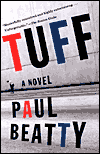I'm interested in matters of property and race, so I tend to be predisposed to read texts (past and present) that way.
I've just finished reading Zora Neale Hurston's final novel, Seraph on the Suwanee (1948), which on the surface is the story of a white woman's struggle to develop a strong sense of self. The woman moves from poor Florida "cracker" status to affluence after she marries a man who is the descendant of former plantation owners. His whiteness, particularly around the turn of the 20th century, afforded him the upward mobility that Blacks and other people of color did not have. Indeed, he amasses a fortune by exploiting the labor and knowledges that nonwhites provide.
Two contemporary short story collections: (Native American Indian) Sherman Alexie's The Toughest Indian in the World, and (East Indian American) Jhumpa Lahiri's Interpreter of Maladies. In particular, each features stories about how whiteness is constructed and desired, particularly as it relates to assimilation.
Alice Randall's The Wind Done Gone, which is, among other things, a parody of Gone With the Wind. What Randall does is rework the plot so that the black Americans at Tata/Tara actually inherit the property that their labor was exploited to build. She also makes Scarlett/Other technically black with a black half sister, Cynara, who serves as the novel's protagonist to illustrate the absurdity of racial formulations. Cynara, the offspring of the plantation Mammy and Planter/Gerald O'Hara, is disinherited at puberty, while her "white" half-sister, Scarlett/Other, is considered a treasured heiress.
Of course, Toni Morrison's The Bluest Eye (1970). If you are not familiar with the story, Morrison uses passages from the Fun With Dick and Jane primer to frame the story of a little black girl who desires blue eyes, the blue eyes that she believes would make her valued and lovable. Morrison shows how the child's parents, and particularly her mother, internalize the dominant society's standards of beauty and self-worth, which internalization undermines their capacity to provide a nurturing environment for their offspring. There are other factors, particularly economic ones, that contribute to the family's deterioration and the little girl's insanity.
I think that ultra contemporary authors like Mat Johnson (Hunting in Harlem,Drop) or Paul Beatty (White Boy Shuffle, Tuff) may offer something useful. Alice Walker's By the Light of My Father's Smile seems to be examining prejudicial behavior on several levels. Black husband and wife anthropologists pretend to be missionaries so that they can acquire funding to study a group of natural Indians in Central America. Their interactions with the Indians reflect their own pre-conceived ideas about "primitive" peoples and their natural ways of being.
These are old, but James Weldon Johnson's The Autobiography of an Ex-Colored Man would seem relevant, as would Charles Chesnutt's work in The House Behind the Cedars, The Marrow of Tradition, etc. Johnson's ex-colored man is light enough to pass. He decides not to declare a racial identity and, thus, effectively passes for white and is able to achieve the social mobility and economic means of any white man with the same talent and drive.
Andrea Lee's Sarah Phillips. Black woman from affluent family travels to Europe and DOES NOT "transcend" racial structures.
Lovalerie King is Assistant Professor in the Department of English at Penn State. Her research interests include African American literature and American law; Black Feminist Thought; African American literary history; and Black women writers.
Professor King's publications include James Baldwin and Toni Morrison: Comparative Critical and Theoretical Essays (Palgrave/MacMillan, forthcoming in 2006); Expropriations and Reparations: A Study of Property, Race, and Ethics in African American Literature (LSU Press, forthcoming); Zora Neale Hurston: An Introduction (Cambridge, forthcoming); A Students' Guide to African American Literature (Lang, 2003).
She has also contributed numerous articles, essays, chapters, and reviews on African American literature to such publications as, Melus, Callaloo, African American Review, Critical Essays on Toni Morrison's Beloved, Black Women Playwrights, The Cambridge Companion to the African American Novel, The Oxford Companion to African American Literature, The Companion to Southern Literature, and other edited volumes.
Many thanks to Lovalerie for such a fine list of books and explanations for how they might help us understand structural racism.
For other posts in this series, see here, here, here, here, here, here, here, and here.
--Marshal Zeringue









